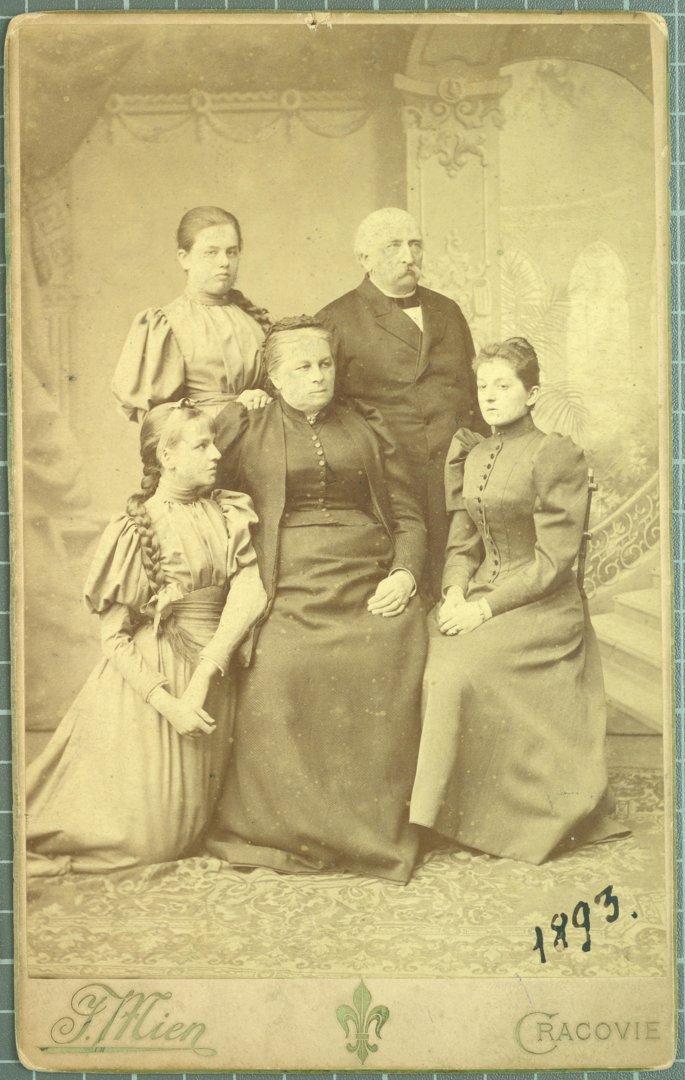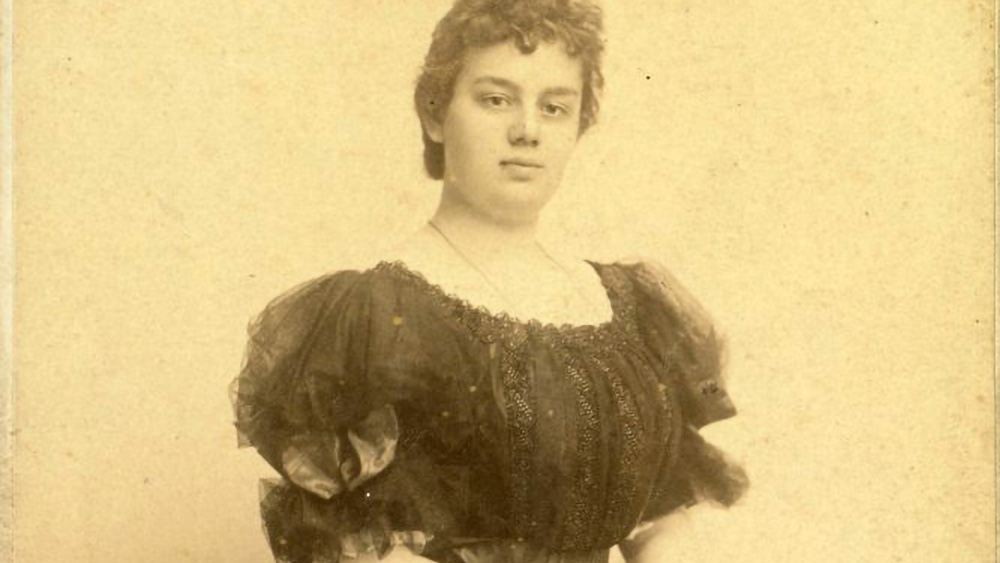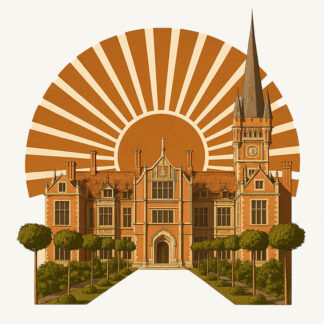Sofija Rožė Marija Tiškevičiūtė-Potocka (Polish: Zofia Róża Maria Tyszkiewicz-Potocka) was the daughter of nobleman Vladislovas Tiškevičius (Polish: Władysław Tyszkiewicz), Count of the Leliva coat of arms, a lawyer, dentist, social activist, collector, and founder of the Museum of the Vilnius Society of Science and Art, and Duchess Marija Krystyna Aleksandra Liubomirska (Polish: Maria Krystyna Aleksandra ks. Lubomirska). In the 1970s, she began writing the Tyszkiewicz family chronicle, Echo of the Last Century: The 19th and 20th Centuries. My Memoirs. This work spans eight volumes, comprising several hundred manuscript pages, supplemented by 25 folders from the archives of the Tiškevičius, Potocki, Liubomirski, and Zamoyski families. The chronicle reveals how the renowned Lentvaris Tiškevičius family lived, how the illustrious Tiškevičiūtė perceived the world, and what Lentvaris meant to her.

Sofija Tiškevičiūtė-Potocka’s father, Vladislovas Tiškevičius, was born in Kretinga in 1865. In 1886, he graduated from the St. Petersburg Law School and relocated to Riga, where he worked as a trainee at the Ministry of Justice and later as a judge. Vladislovas maintained good relations with local Poles and formed a friendship with one of them, Prince Konstantinas Liubomirskis. During a visit to his friend’s home, Sofija’s father saw a photograph of a strikingly beautiful girl and declared that she would be his wife. Unbeknownst to the young suitor, the beauty was Konstantinas Liubomirskis’s sister, Marija Krystyna. Vladislovas Tiškevičius requested her photograph, which was neither simple nor socially acceptable at the time. Initially hesitant, Konstantinas eventually relented and gave his friend the photograph on the condition that he show it to no one.
Vladislovas and Konstantinas spent their holidays together in Lentvaris, Vokė, Palanga, and Kretinga, as well as in Warsaw, at the home of Konstantinas’s relative, the elderly Stefanas Liubomirskis. There, Vladislovas made a favorable impression on Stefanas and, with his support, traveled to Krušyna, the Liubomirskis family estate, to ask for the hand of the beautiful Marija Krystyna.
Raised in luxury and surrounded by the love of her parents and four brothers, the duchess was not yet ready to marry and move to her husband’s home. The persistent suitor visited Krušyna regularly, proposing to Marija Krystyna each month. Gradually, Vladislovas won the affection of those around her, including her parents, and after four years, he captured her heart. Their engagement took place on Christmas Day in 1891, and the wedding was held on April 25, 1892. Afterward, the newlyweds settled in Lentvaris.
Their marriage was successful, and the couple had four children, all born in Warsaw. On February 8, 1893, their eldest child, Sofija Rožė Marija Tiškevičiūtė-Potocka, was born, followed by Steponas Eugenijus Marija Tiškevičius (Polish: Stefan Eugeniusz Maria Tyszkiewicz) on November 24, 1894, Rozalija Rožė Tiškevičiūtė-Micielska (Polish: Rozalia Róża Tyszkiewicz-Mycielska) on April 10, 1897, and Eugenijus Stanislovas Marija Tiškevičius (Polish: Eugeniusz Stanisław Maria Tyszkiewicz) on January 21, 1901.
In April 1892, Sofija Tiškevičiūtė was baptized and brought from Poland to Lithuania, to the Lentvaris estate, where she was cared for by a wet nurse, Antonina Žukovska, the wife of a Lentvaris coachman, and a nanny, Liudvika Metlevič-Friedenstal, who, after her husband’s death, worked for wealthy landowners to support her two young daughters.
The relationship between parents and children in the family was close and warm. As Sofija recalls, the children always visited their parents’ room before bedtime to wish them goodnight. Before the children went to sleep, their father, Vladislovas, would stop by, never disappointing them, and mark their foreheads with the sign of the cross.
The chronicle also reflects the strict upbringing typical of noble families—children were not allowed to do as they pleased. For instance, until a certain age, they were prohibited from sitting at the dining table and eating with adults.
Sofija vividly remembers 1903, when she was 10 years old and her brother Steponas was 8. That year, they earned the right to dine with adults at the same table. Their uncles, and especially aunts, observed their table manners and behavior with a critical, scrutinizing gaze. Mademoiselle Jeanne discreetly monitored and corrected their mistakes. Children were not permitted to speak at the table, only to provide brief answers to questions.
In the afternoons, the children could go for a walk or attend riding lessons, which they had three times a week. They quickly learned to ride and particularly admired their mother, an exceptional rider, with whom they could now ride together. (The love for horses, deeply instilled in childhood, remained with Sofija and Eugenijus into adulthood. Sofija rode even during her final month of pregnancy, nearly losing her only son when she was thrown from a horse near Paneriai while traveling from Vilnius to Lentvaris). Sofija likely had no inkling that three years later, fate would take her to Italy.
The year 1904 is notable in history for the adoption of the famous “Tiškevičius Memorandum,” which opposed the Tsarist regime’s anti-Polish policies and proposed autonomy for the Kingdom of Poland. On November 30, 1904, at Vladislovas Tiškevičius’s initiative, approximately 200 educated landowners and intellectuals from across the country gathered in Warsaw to address the situation arising from the Russo-Japanese War. The meeting resulted in the adoption of the Tiškevičius Memorandum, which discussed the long-silenced and painful Polish question, the situation of Poles under occupation, and expressed the idea of autonomy for the Kingdom of Poland, while also addressing the public’s passivity in the press.
In December, Vladislovas Tiškevičius presented the memorandum to the Minister of Internal Affairs in St. Petersburg. Naturally, this displeased the Tsarist authorities, who also disapproved of Vladislovas’s stance against anti-Jewish pogroms. Consequently, when the Duma, in which Vladislovas was a deputy, was dissolved in 1906, the Tsarist regime seized the opportunity to exile him to Arkhangelsk. Fortunately, his father had influential contacts, and Vladislovas eventually ended up in Milan, Italy, where his family visited him in 1907.
In 1911, Sofija passed her final exams in Milan and, as she wrote in her memoirs, was “recognized as an adult lady,” eligible to marry. A serious lady had to look the part, and great attention was paid to her appearance. Sofija was given a suitable hairstyle, and her wardrobe was updated. To complement her dresses, she had to select hats, shoes, gloves for various occasions, stockings, parasols, handbags, and many other small accessories, which were essential for her debut. Her first ball, where she was introduced to high society, took place at the Hunters’ Club on Kredytowa Street in Warsaw. Sofija wore a white sundress adorned with Irish lace and a red-orange shawl. As a debutante, Tiškevičiūtė opened the ball by dancing the waltz “By the Danube” with Andrzej Żołtowski. That evening, Sofija was an exceptional dancer and received many flowers.
In 1914, the First World War broke out, affecting the Lentvaris Tiškevičius family as well. Sofija recalls how people fled from border areas deeper into the country and how Vladislovas Tiškevičius provided them with shelter for the night. Her parents even allocated several buildings for a Red Cross hospital. Sofija and her mother’s brother, Konstantinas Liubomirskis, assisted in these efforts. In the hospital pharmacy, under the supervision of a nurse, Sofija prepared ointments and occasionally helped during surgeries. Dr. Brem noticed that Sofija was unfazed by the smell of ether and reassigned her to care for the severely wounded.
In 1915, alarming news of approaching Germans caused widespread fear, particularly when airplanes appeared over the Lentvaris area. The bombings terrified everyone, prompting people to flee their homes at the sight of an aircraft. This took a toll on the health of Sofija’s younger sister, Rožė Tiškevičiūtė, who stopped walking and remained bedridden for weeks. As a result, their mother decided to send Rožė to the family’s apartments in Vilnius, which were reserved for such emergencies if they had to leave Lentvaris.
The family was forced to abandon Lentvaris in 1917 when a Tsarist general delivered a telegram to Sofija’s father, Vladislovas, ordering a retreat. Panic ensued, as Vladislovas had to evacuate with the hospital, while his family headed to Vilnius. Thus, the family was separated.
Eventually, the Germans occupied Vilnius. As the occupiers marched through the streets, Sofija and her relatives stayed indoors, as did other residents, fearing the occupiers’ attitude toward locals. The Germans established a civilian office, and gradually, all residents replaced their Russian passports with German ones, complete with photographs and fingerprints. Sofija’s mother, with her charm and diplomatic skills, won the favor of the Germans, securing a permanent permit to visit the Lentvaris, Trakai, and Užutrakis estates. Her children eagerly accompanied her on these trips.
However, the situation remained challenging, and in 1917, due to hardships, Marija Krystyna Tiškevičienė decided to relocate her children to Warsaw. She returned to Lithuania for certain matters but later rejoined her children.
In 1918, Marija Krystyna and her children stayed at her family’s estate in Krušyna, where Vladislovas Tiškevičius finally returned. The family’s reunion after their separation was an extraordinarily joyful moment in their lives.
In 1922, Sofija Tiškevičiūtė’s life changed when she and Klemensas Potockis received permission to marry. He was a sensitive, even sentimental man who longed to have his own home and family. The wedding was scheduled for August 26 and was to be a quiet ceremony in the small wooden Lentvaris church, as the brick church was still under construction. The newlyweds lived in a small administrative house, as the Lentvaris palace had been devastated after 1920, and the estate’s economy was struggling.
In Warsaw, the couple led an active social life: dance evenings, dinners with friends or relatives, and gatherings at embassies. In March, they returned to Lentvaris, where Sofija’s mother allocated them several hectares of land for growing vegetables. The produce was sold at the Vilnius market, bringing significant income to the family. They also raised horses, cows, and pigs. After some time, an overseer ordered the cessation of this activity, as he disapproved of it. Klemensas, lacking a profession, eventually found himself in Brest, marking the couple’s first separation after their marriage.
Following the 1921 Treaty of Riga, part of the Tiškevičius lands fell under Soviet control, while another part remained in Lithuania. The border was just a few kilometers from the palace. Due to the proximity of the border, Sofija’s mother, Marija Krystyna, was reluctant to restore the palace, citing the threat of war and stating that the family’s presence in Lentvaris was temporary.
In 1932, Sofija Tiškevičiūtė-Potocka’s father was diagnosed with multiple sclerosis. The disease progressed rapidly, and he often failed to recognize his loved ones. Sofija’s mother cared for him, assisted by an old servant, Boleslovas Lelevskis. For four years, Vladislovas remained paralyzed.
By the end of summer 1936, his condition deteriorated significantly, but no one expected his death to come so quickly. On August 23, 1936, he passed away, and Sofija did not arrive in time to see him alive.
She recalls her father’s funeral, describing how she accompanied him along a beautiful lakeside avenue he loved to walk. Lentvaris was his cherished creation, so it was no surprise that the entire local community attended his funeral, including a rabbi with a Jewish delegation. Vladislovas was laid to rest in a chapel near the church.
Three years later, the outbreak of the Second World War scattered the Tiškevičius family and forced them to leave their beloved Lentvaris forever. Sofija departed immediately at the war’s onset, and other relatives gradually left Lithuania. After the war, Sofija ran an antique shop in Warsaw. Her husband had been interned in a camp, and her son perished in a concentration camp. Post-war, Sofija operated a small kiosk selling coffee and pastries, later opening a modest antique shop. She passed away in 1989 in Warsaw.
Sofija’s niece recalls: “Aunt Sofija was an exceptionally warm person, loving all of us, with a remarkably cheerful disposition. She could captivatingly recount her childhood in Lentvaris, her travels, historical fashion, and carnival traditions. She read extensively and thrived in public gatherings. When the Pope from the Vatican visited Poland for the first time after the war, she translated his sermon from Italian for the bishops in Warsaw. In her final years, Potocka lived in a modest, small apartment in Warsaw’s Grochów district, at Suchodolska 4a. Relatives from both her father’s and mother’s sides tried to support her morally and financially. However, instead of easing her own life, she chose to support the Church”.
Sofija Tiškevičiūtė-Potocka succeeded in passing down to her descendants what she had collected and prepared over many years, including the essence of her life’s purpose. The Second World War mercilessly dispersed the Tiškevičius family across the globe and tore apart their family nest, yet her legacy endured.



